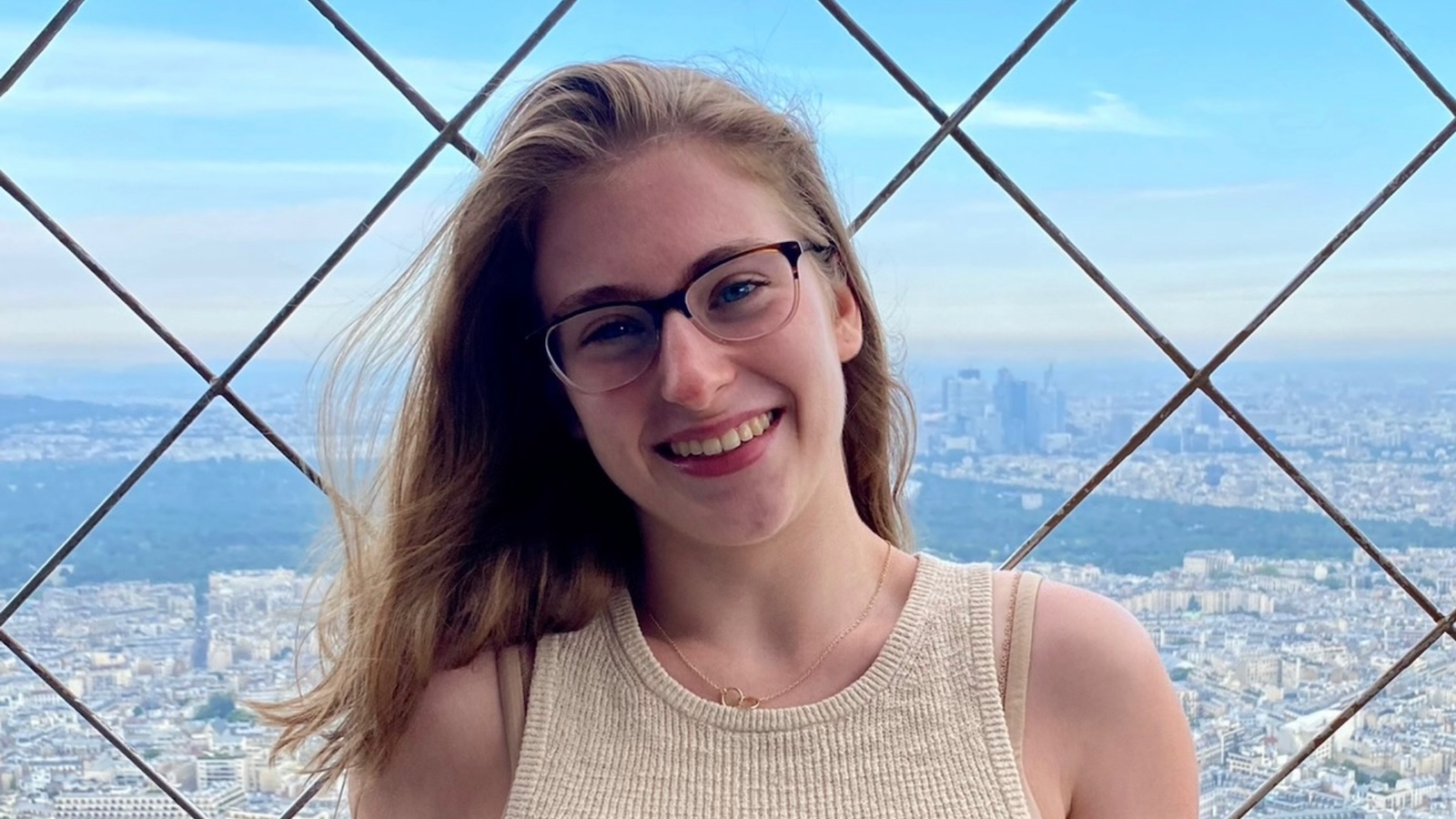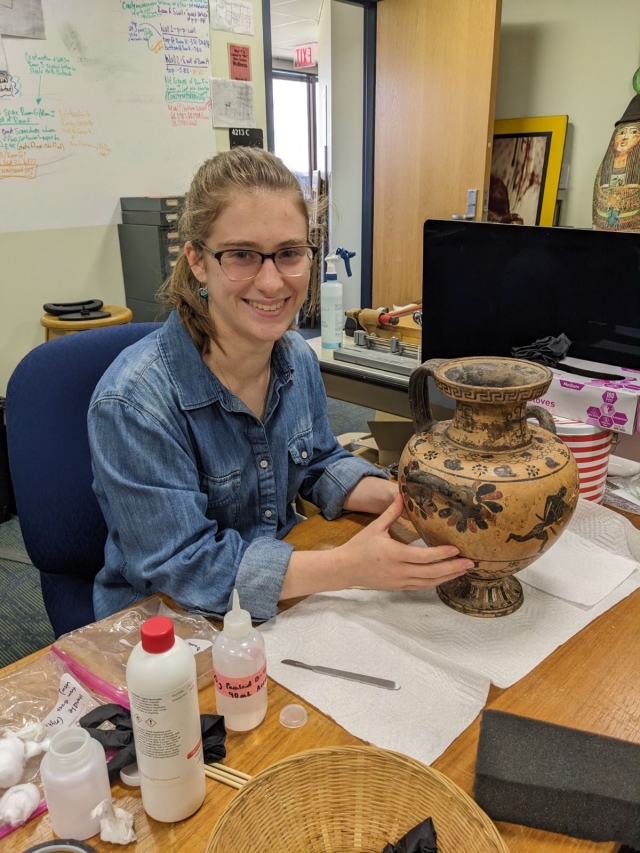A Future in Conservation
May 21, 2025

At UMD, graduating senior Lylah Messinger restored a 2,500-year-old Etruscan vase. Now she’s headed to graduate school in London.
By Jessica Weiss ’05
In a small campus lab, senior Lylah Messinger worked under UV light to examine the surface of a 2,500-year-old Etruscan hydria. The ancient vase, housed in UMD’s Department of Art History and Archaeology, had been repaired once before arriving at the university—but Messinger quickly found issues: outdated materials, poor restoration methods and residue that obscured the original painted designs.
Over the course of nearly a year, she documented more than 130 fragments, built digital 3D models and mechanically cleaned, conserved and restored the rare object—ultimately identifying it as one of only about 40 of its kind in the world, likely used during a burial in ancient Italy.
The experience—during an internship at the Michelle Smith Collaboratory for Visual Culture—was a defining one for Messinger, an honors student graduating Phi Beta Kappa this week with degrees in art history and classics and a minor in archaeology. She later presented her research about the hydria—which also formed her undergraduate honors thesis—at the 12th Annual Tennessee Undergraduate Classical Research Conference. This fall, she’ll take the next step in her conservationist journey by beginning a prestigious graduate program at University College London.
“Working on the hydria was what cemented this as a career path for me,” Messinger said. “It showed me that I would enjoy doing this for a long time.”
Messinger has long been drawn to art. Working in oil paint, charcoal, pastel and acrylic, she’s created everything from feminist protest pieces to expressive portraits and abstract works. At UMD, she knew she wanted to keep working with her hands—but wasn’t yet sure how.
During her freshman year, while still undecided on a major, she took a classics course with Associate Professor Jorge Bravo, who is also an experienced field archaeologist. The course focused on archaeological objects and iconography, studying figures and stories from classical Greek and Roman civilizations, and Messinger said Bravo’s passion for the material was contagious.
“To actually see the objects and realize that it’s not just pots—the pots have drawings, paintings, stories, myths behind them—that really fascinated me,” she said.
She found herself drawn not only to the visual material, but to the analytical writing and research as well. Encouraged, she enrolled in an introductory art history course—and also loved it. By the end of her freshman year, she had declared both majors and added a minor in archaeology to gain more hands-on experience. While her classics courses gave her a foundation in the languages, literature and social structures of ancient civilizations, art history helped her explore how those cultures expressed themselves through objects.
That summer, she traveled to Menorca, Spain, for a weeklong archaeological excavation of Sanisera, a Roman port city. Working on a domestic dwelling just outside a Roman basilica, she uncovered artifacts dating from the second century B.C. to the sixth century A.D.—including 30 coins, a rare deposit of jewelry and an intact oil lamp with a unique rabbit motif. She practiced field techniques like stratigraphic analysis, sample collection and lab documentation.
While she valued the experience, Messinger realized she was more interested in working with artifacts indoors, such as in labs or museums, where she could help preserve and interpret them for others. Though UMD didn’t offer a formal conservation track, her interdisciplinary studies were ideal preparation. She also found valuable mentorship in Bravo and Associate Professor of Art History Emily Egan, an Aegean prehistorian and field archaeologist, who helped her chart a path toward conservation and apply for competitive study-abroad programs. One such program took place the summer after her sophomore year, when Messinger interned with the Balkan Heritage Foundation at the ancient city of Stobi in North Macedonia, where she conserved and restored Roman ceramic artifacts and created technical drawings for documentation.
Bravo said he knew upon meeting Messinger that she was “endowed with a natural curiosity about the ancient world, especially its archaeology.”
“She was always eager to voice her questions and comments in class, and frequently she would stop me after class to share further ideas and questions,” he said.
Messinger also completed rigorous coursework in chemistry, including two semesters of organic chemistry, a key requirement for graduate programs in conservation. By the time she joined the Michelle Smith Collaboratory as an intern during her junior year, she had amassed both technical and academic expertise. Collaboratory Director Quint Gregory and Associate Director Christian Cloke entrusted her with the complex hydria restoration project, which required everything from photogrammetry (the process of creating 3D models from photographs) and 3D modeling to careful cleaning and materials testing—techniques she learned during her internship.
“She answered real archaeological questions by dealing with artifacts,” said Egan, “learning about their history and context, and also bringing to bear the full range of her humanistic and scientific education at UMD and outside of it.”
This fall, Messinger will begin the first phase of her two-part graduate program at University College London. She hopes to eventually work in a museum, but also be able to go on archaeological digs to do on-site conservation work when objects can’t be transported. For Messinger, object conservation is more than technical restoration—it’s about making history tangible and helping others connect to it.
“All societies can be defined in part by what they leave behind,” she said. “Objects reflect our habits, our beliefs, our values. I want people to understand history not just through a textbook, but by experiencing an object in front of them—just like people of the time would have. That’s how I visualize and understand the past, and I think it’s how others can, too.”


